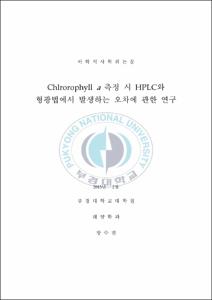Chlorophyll a 측정 시 HPLC와 형광법에서 발생하는 오차에 관한 연구
- Alternative Title
- A study on the errors occurring in HPLC and fluoromtry in measuring chlorophyll a
- Abstract
- There are disagreements among measured Chl a concentration by the different methods. Samples collected in the East China Sea in May and August, 2014, were compared chlorophyll a concentration measurement using HPLC and fluorometric methods in order to contribute to the utilization by common using chlorophyll a data to be analyzed in variety of methods. Also, tissue grinding procedure of HPLC analysis requires a lot of time and experience. We measured the concentrations of photosynthetic pigments before and after the grinding, in order to understand the grinding effects on the quantitative analysis of chlorophylls and carotenoids.
In this study, regression analysis using HPLC versus fluorometric method in May and August 2014, shows that fluotometric determinations underestimated chlorophyll a by 32% and 26%, respectively. The errors of chlorophyll a determined by acidified fluorometric measurement were correlated with chlorophyll b interference. In some areas of this study area, the fluorometric method overestimated chlorophyll a because of high concentrations of chlorophyll c along with the fucoxanthin as accessory pigment of diatoms. However, in the East China Sea, overall high in the chlorophyll b/a ratio, caused greater underestimation of chlorophyll a and overestimation of pheopigments. Relative errors were within an average of 10% and this study found that two methods can equated by t-tsest. However, temporal and spatial changes in the relative proportion of chlorophyll b containing phytoplankton will result in significant errors in the fluorometric determination of chlorophyll a.
When tissue grinding procedure was omitted, we found that chlorophyll a concentrations in the East sea and East China Sea were underestimated up to 45%, 52% in average, respectively. We found that the smaller the phytoplankton, the bigger underestimation of their biomarker pigments concentration is likely to happen due to the incomplete extraction. Therefore, tissue grinding procedure should be included for HPLC analysis in all cases, to prevent the underestimation of not only chlorophyll a but also carotenoids pigments. Thus, HPLC and Fluorometric method are difficult to complementary substitution in the East China Sea, tissue grinding procedure should not be omitted in order to provide accurate chlorophyll a concentration.
- Issued Date
- 2015
- Awarded Date
- 2015. 2
- Type
- Dissertation
- Publisher
- 부경대학교 대학원
- Alternative Author(s)
- Jang, Su Jin
- Affiliation
- 부경대학교 대학원
- Department
- 대학원 해양학과
- Advisor
- 박미옥
- Table Of Contents
- Abstract ⅰ
List of Figures ⅲ
List of Tables ⅴ
Ⅰ. 서 론 01
Ⅱ. 재료 및 방법 06
1. 연구 해역 06
1-1. 동중국해 06
1-2. 동해 09
2. 식물플랑크톤의 광합성색소 분석법 11
2-1. HPLC (High-Performance Liquid Chromatography) 11
2-2. 형광법 (Fluorometry) 19
3. Chl a 농도 측정의 방법 간 비교 20
4. 여과지 분쇄 효과 평가 22
Ⅲ. 결과 및 고찰 23
1. 형광법과 HPLC를 이용한 Chl a 농도 측정 23
1-1. Chl a 농도 측정 결과 23
1-2. Chl a 측정 방법에 따른 비교 31
2. 광합성 색소의 여과지 분쇄 효과 42
2-1. Chl a 42
2-2. Carotenoids 43
2-3. 색소 농도에 따른 분쇄 효과 47
2-4. RChla 의 수평 분포 50
Ⅳ. 결 론 54
Ⅴ. 참고문헌 57
요 약 68
감사의 글 70
- Degree
- Master
- Files in This Item:
-
-
Download
 Chlorophyll a 측정 시 HPLC와 형광법에서 발생하는 오차에 관한 연구.pdf
기타 데이터 / 2.84 MB / Adobe PDF
Chlorophyll a 측정 시 HPLC와 형광법에서 발생하는 오차에 관한 연구.pdf
기타 데이터 / 2.84 MB / Adobe PDF
-
Items in Repository are protected by copyright, with all rights reserved, unless otherwise indicated.